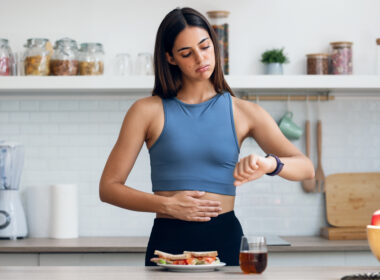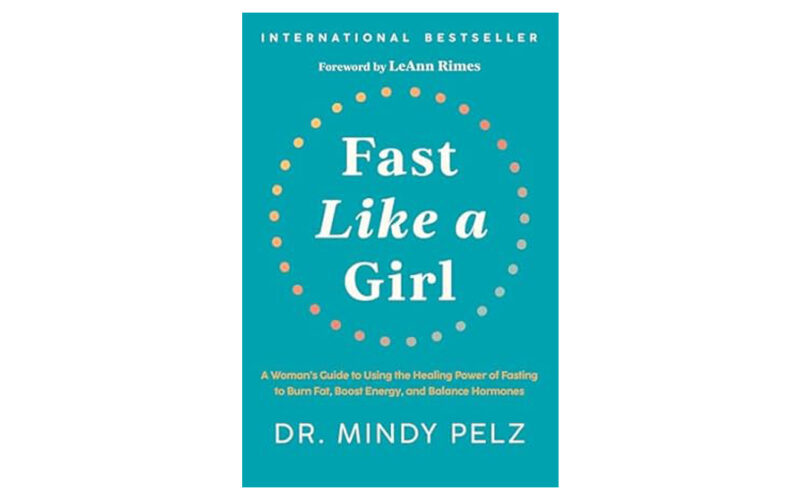It seems impossible for a woman to reach adulthood without bumping into, and likely trying, some fad diet or diet program. Older relatives swear by Weight Watchers or South Beach. Your friend’s sister’s roommate who just had a baby lost all the weight in just 2 months by going keto. You remember the few years when everyone tried doing Whole 30? Only a few strong-willed souls survived the month.
These diets all promise something—the hope of weight loss and better health, improved mental health, a faster metabolism, relief from pain or inflammation, an improved immune system, greater alertness, better fertility, and so on.
In Fast Like a Girl Dr. Mindy Pelz promotes the benefits of fasting for weight, gut health, increased energy, improved mood, hormone regulation, and some functional benefits such as “increased autophagy,” which you can think of as streamlining the waste management process of each cell in your body. But unlike other one-size-fits-all fasting diets, Dr. Pelz ties the stages of her diet to the phases of the female menstrual cycle. This, she writes, maximizes the benefits of fasting without depriving the body of needed nutrients during cyclic phases of renewal. Despite its slightly ingratiating “gal pal” tone and scattered not-so-subtle self-promotion plugs, Fast Like a Girl offers a unique and scientifically-backed diet alternative for women seeking to improve their health through food (and the ways they consume it). Here’s our take on whether to buy, borrow, or skip this book.
Dr. Mindy H. Pelz is a chiropractor and health influencer with 1.1 million followers on YouTube and over 600k followers on Instagram. She has a podcast, The Resetter Podcast, and has authored three other food- and health-related books. She has spent the recent past immersed in metabolic health literature and practice.
In the introduction to Fast Like a Girl, Dr. Pelz shares that her motivation for writing this book is to help tackle the surge in chronic illness impacting women and the lack of treatments designed for women’s unique needs. When she was in her late teens, she turned to a holistic doctor for treatment for extreme fatigue after being told by a traditional doctor that there was no cure. The holistic doctor helped her reshape her diet, curing her fatigue in just a few weeks. Since then Dr. Pelz has been dedicated to learning about improving metabolic health, meaning the body’s ability to regulate blood sugar, cholesterol, and blood pressure.
Who is the intended audience of Fast Like a Girl?
This book is generally aimed at adult women, but since the diet is oriented to the menstrual cycle it is more specifically for cycling women in their fertile years. Dr. Pelz’s frequent mentions of her YouTube channel and other personal anecdotes further narrow the target demographic to menstruating fans of the author. And since eating based on your menstrual cycle phase is the foundation of the book, but the only recommendations for identifying your cycle phase are Rhythm Method-based, the audience for whom this book is most helpful is further limited to naturally cycling fans of the author who already know how to accurately recognize their fertility biomarkers.
What are the main content areas of Fast Like a Girl?
Cover-to-cover, this book is a little over 300 pages, but about half of it is dedicated to recipes, references, and an index. The author begins the book by discussing the reasons other diets don’t work as well as this one. Then she touts the many benefits of fasting diets for women’s health that are hypothesized to come from our hunter-gatherer genetic background during which our ancestors spent extended periods without food consumption. In theory, the drop in blood sugar and lack of need to digest food during fasting allowed the body to repair itself, increase focus, and balance hormones. Dr. Pelz briefly touches on the science behind the health benefits before moving on to part two—the diet itself.
This section begins with encouragement to take ownership of this diet journey and then discusses what one should eat when a fasting period has ended. Next, she outlines the different diet phases tied to the phases of the cycle (including why fasting during the days before your period may be a bad idea). Finally, she walks the reader through a 30-day fasting reset and some tricks for making fasting a more positive experience. The rest of the book is dedicated to recipes for when the reader breaks her fast.
Strengths of Fast Like a Girl
The author is clearly passionate about the power of this diet. She has seen some amazing results from clients who follow the advice in this book, and optimistically shares those stories as hope for women looking for solutions related to fertility, well-being, etc.
I was surprised by how convincing Dr. Pelz is about the benefits of this diet. This book was a “curiosity read” for me, as a young gluten- and dairy-intolerant nursing mother who struggles to get enough calories as it is. Yet, after reading the book, I am interested in trying one of the shorter fast resets, such as the Gut-Reset fast that only lasts 24 hrs, which she briefly overviews.
The advice shared about how to eat when not fasting was another strength of Fast Like a Girl. Of course, recommendations to increase pre- and probiotics, decrease sugar, increase food that improves estrogen and progesterone production, and cut back on processed carbs are not novel for contemporary women’s health books. However, implementing these recommendations will make a dramatic difference for a reader who has not encountered them before.
Finally, the greatest strength of Fast Like a Girl is a foundation from which a naturally menstruating woman can build a fasting diet for herself. This book contains the basic information needed to make an informed decision about whether this diet is right for you and how to begin implementing it into your lifestyle.
Limitations or blind spots
The most glaring blindspots in this book are the lack of discussion related to properly identifying the phases of the menstrual cycle and the failure to mention that women on hormonal birth control do not experience the different phases of the cycle. This means women on birth control will not experience the benefits specifically related to matching fasting behaviors to varied cycle phases. The author promotes this cycle-based diet as beneficial to all women, which might be true, but seems a bit hypocritical given that this diet is supposed to correct the one-size-fits-all problem other diets have.
The frequent self-promotion and push to refer to her YouTube channel are further limitations of this book. The author could have corrected this by being more open that this book was not a “woman’s guide to using the healing power of fasting…” but more accurately “Dr. Mindy Pelz’s literary guide to implementing the health advice detailed in her social media content.”
Finally, this book lacks depth of knowledge and true discussion of the pros and cons of fasting compared to other diets. Many of the health benefits Dr. Pelz claims come from the fasting diet can also be found in simply changing one’s eating habits to match the food recommended when you begin to eat again after a fasting period. The author also waits until the end of the book to discuss how this diet might lead to side effects like hair loss, cycle changes, insomnia, pain, fatigue, and, of course, hunger, to name a few.
This diet certainly is not for every woman, but should one commit to trying it I believe most women would be capable of succeeding. If I were discussing this diet with a friend, my takeaway would be that implementing some aspects of the diet without going all-in would be the ideal balance. For example, eating for optimal hormone production could mean not eating for a few extra hours on certain days. Or, as mentioned before, leaning into the nutrition recommendations for breaking a fast is an easier way to dip your toes into this diet without a complete lifestyle overhaul.
A woman interested in going all-in should ask herself some questions before beginning the diet. Am I in a place personally, familially, and professionally to power through the fatigue and hunger that will come with adapting to this diet? What is my motivation, and is this the best diet for my goals? Have I struggled with control or hunger-related diets in the past (eating disorders specifically)? If your answer to the last question, in particular, is a “yes,” this book might not be for you.
The verdict: To buy, borrow, or skip Fast Like a Girl altogether?
Fast Like a Girl could be an interesting read for anyone interested in a CliffsNotes on metabolic health and the benefits of fasting, but there are arguably more informative books out there for someone looking to learn about this beyond the surface level. The Complete Guide to Fasting by Jason Fung comes to mind. Other books on what to eat for women’s health and fertility include The Fertility Diet by Jorge Chavarro, Walter C. Willett, and Patrick J. Skerrett, and The Better Period Food Solution by Tracy Lockwood Beckerman, in addition to Lily Nichols’ Real Food for Pregnancy and Lara Briden’s Period Repair Manual, both previously reviewed by Natural Womanhood.
Perhaps most tellingly, if a menstruating female friend asked me for a book recommendation about eating for women’s health, I would send her many books, but not this one. That being said, I hesitate to discourage the curious reader or fan of Dr. Pelz from reading this book. The information inside, though quite generalized, was interesting. I am glad I read it despite being disappointed that it did not live up to its potential as the antidote to one-size-fits-all diets.
I would recommend borrowing this book if you have some spare reading time and like to learn about diets and metabolic health. Most women could skip it, and any woman reading it in search of the right diet for herself should pair it with other women’s health books to ensure a well-rounded view.
Additional Reading:
PCOS and diet: Can intermittent fasting help improve fertility?







